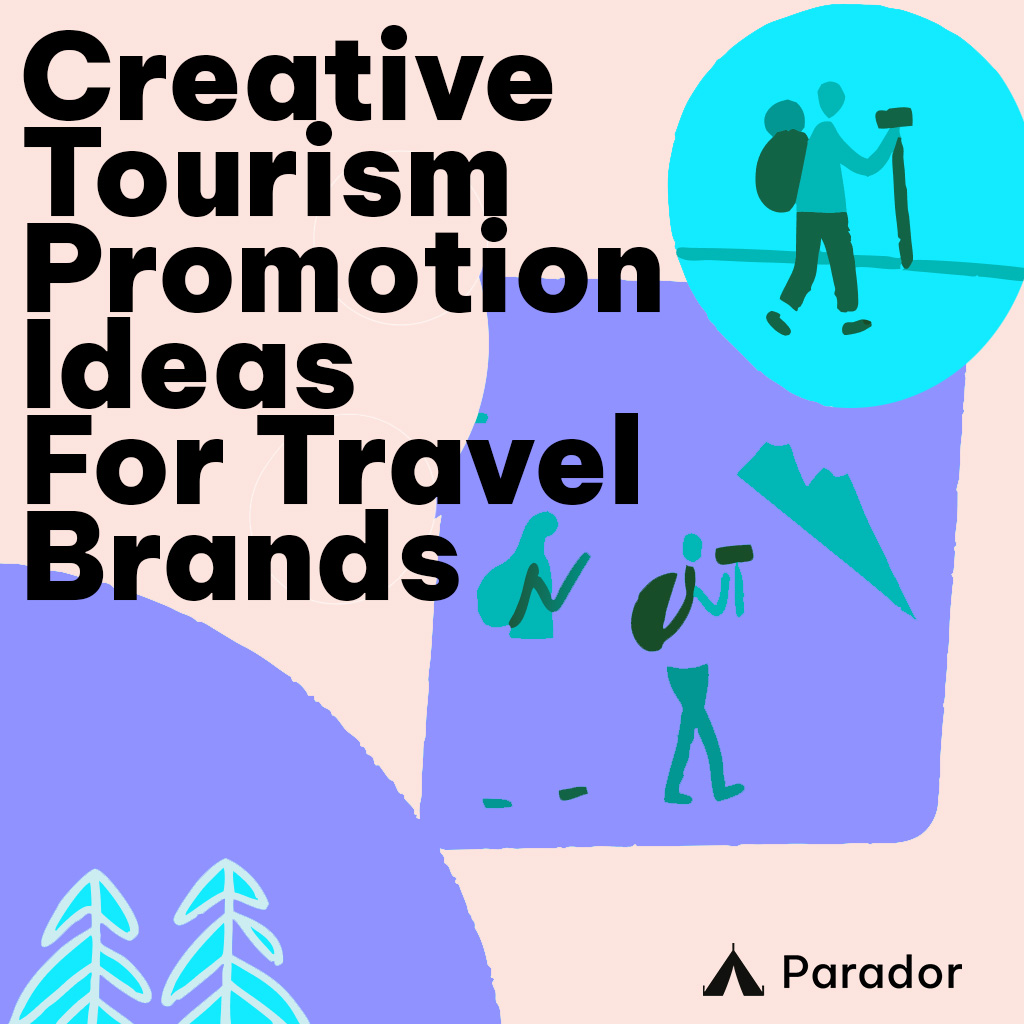
With travelers expected to spend 9% more on travel in 2025, savvy tourism companies can look forward to a potentially lucrative year in travel. However, you’re going to need some creative strategies to differentiate yourself from the breadth of competition.
You’re probably already aware of the basic advice: optimize your OTA listings, maintain a strong social media presence, do SEO, and run paid ads.
This article, however, will explore 12 slightly unique ideas for creative tourism promotion. They’re intended to help you think outside the box, attract the specific audience that are looking for your offering, and get more bookings for your tours, transport, retreat or accommodation. Let’s go!
1. Strategic travel content marketing
Digital marketing for tourism is essentially about exposing your target audience to your offering, then building and maintaining a rapport with them so that when the time comes to book a trip, that person is thinking about your offering before anyone else’s.
People don’t see an advertisement for a holiday and decide: ‘I’ll book that holiday right away’. That’s not the goal of the advertisement. The goal of the advertisement is to ‘suggest’ the idea of the holiday to the person that is being marketed to, so when they do eventually want to book their trip, it’s the particular brand of the advertisement that comes to mind.
Large multinational companies use billboards, TV and paid media advertisements to build a perceived familiarity with their audience. For smaller and boutique travel brands, the way to build that rapport is with content marketing.
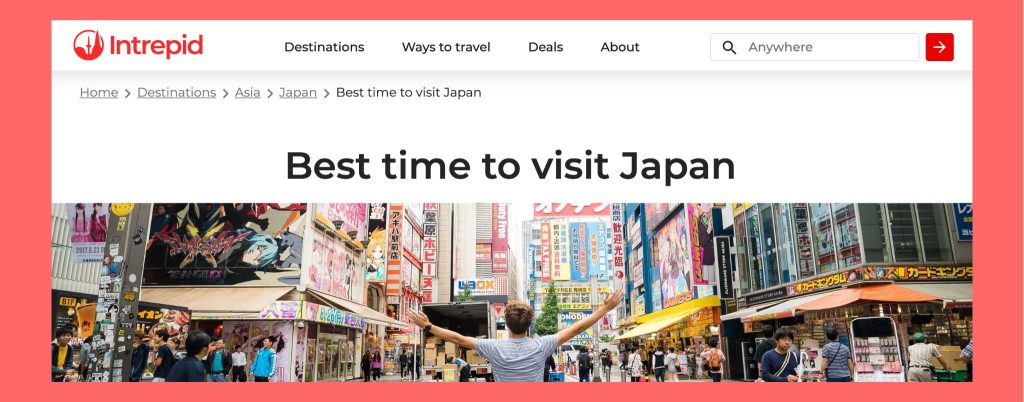
Effective content marketing positions your travel brand as an authority in your space. It brings potentially interested travelers into your sales funnel, and allows you to get them on your email list to give them offers and seasonal discounts.
We generally recommend specialized SEO content marketing to our clients. This involves producing a set amount of written content per month to publish on your website, which targets keywords that your ideal target audience are searching for.
We see several huge benefits of this type of content marketing for tourism:
- It puts your brand on the radar of potential bookers and allows you to incorporate them into your marketing funnel
- It gives you a platform to showcase your offering to people who are looking for services like yours on search engines like Google
- It brings people directly to your website, reducing your reliance on third parties like OTAs and social media platforms
- It provides you with genuinely interesting content which can be repurposed for social media posts, email campaigns and direct marketing
TIP: show direct booking discount banners when users land on content, creating FOMO and encouraging conversions.
Content marketing begins with keyword research to identify what travellers are searching for.
Then, you’ll need to write engaging, SEO-optimized content around those keywords (which can also be repurposed for social media and your email list), and publish the new content on your website at a regular cadence. This will attract people from search engines like Google to your site, from where you can encourage them to sign up to your newsletter or make a direct booking with lead magnets such as exclusive or limited-time offers.
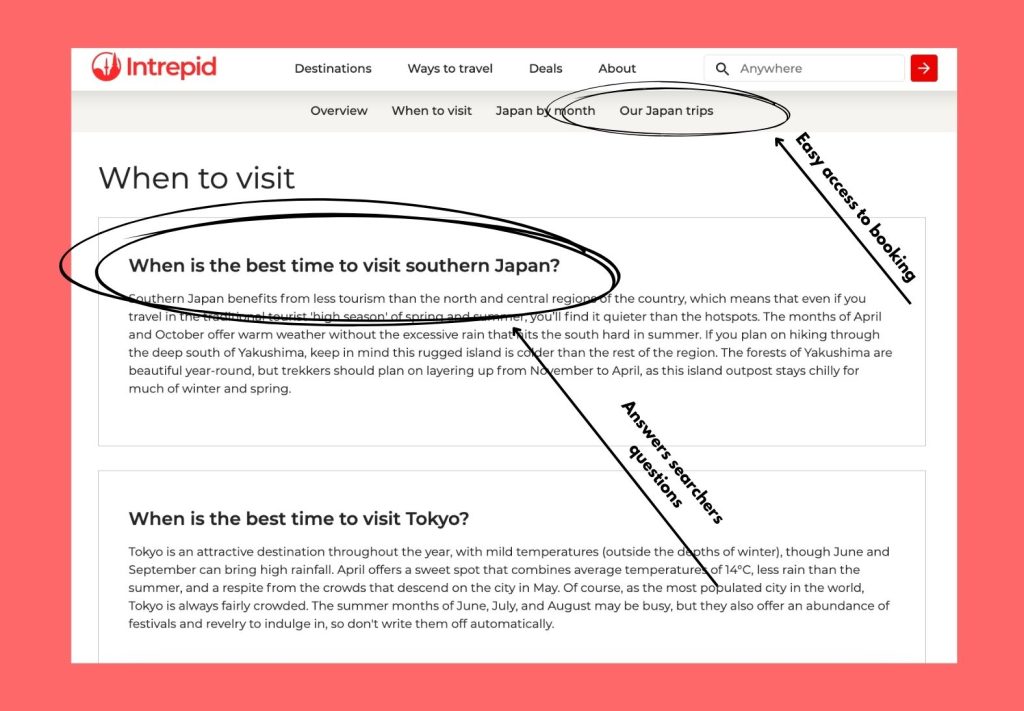
With 35% of travelers finding their travel inspiration from search engine results (making it the third biggest source of information for global travellers), we truly believe that having a well-defined SEO content marketing strategy in place is the key to bypassing the traditional tourism promotion channels and gaining a sustainable stream of interested bookers.
Action steps:
- Carry out keyword research and plan a content calendar around topics that your target audience are searching for
- Write SEO-optimized content and populate it with CTAs and lead magnets for your email list or booking links
- Watch your direct bookings grow and reduce your reliance on OTAs
Interested in outsourcing your targeted travel content marketing with Parador? Visit the Travel Content Pro page and see how you can start winning direct bookings from search engines.
2. Tap into travel trends
While many travel companies have very specific offerings intended to attract very specific audiences, we always advocate looking ahead into the state of travel trends and seeing if there are any untapped tourism promotion ideas that can help you stay competitive.
For example, tourism brands can look into travel trends like sustainability, ecotourism and digital detoxing, all of which reflect a broader shift in ‘traveler values’. People are seeking more unique and responsible ways of exploring; why not refine your messaging or develop tailored experiences to position yourself in a way that will attract these kinds of travelers?
Even if your business doesn’t have a focus on trends like these, you can highlight aspects of your existing offering that resonate with them so that travelers who value these trends can feel aligned with you.
For example, hotels can speak about local and responsible sourcing of ingredients in their restaurant, or tour companies can introduce off-the-grid experiences to cater to those looking for a digital detox. Think about who your local suppliers, or how your business helps the local area and economy, and find a way to weave that into your messaging.
Tools like Google Trends–or simply talking to your guests in-person–can help you to keep a pulse on what’s going on in the industry. If you make adjustments to your branding to align with these interests, you’re likely to attract more engaged travelers looking for these kinds of experiences.
3. Retarget travelers who show interest your offer
Many travelers browse multiple options before booking, and a large proportion of them may click onto your site and then leave again to carry out further research. Ad retargeting works by identifying users who have previously engaged with your website, clicked a link, or interacted with your content on social media (using a pixel embedded in their browser). It then displays your offering to them again, on a different platform or website, at the moment they’re ready to book.
Retargeting potential bookers like this is especially effective, because they’re already pre-qualified – aka, they’ve already shown an interest in your service – but just may not have been ready to book at the time. In an advertising landscape where tour operators waste 30% of marketing budgets on irrelevant ad targeting, this kind of dynamic, focused advertising offers a significant advantage over traditional ads. Retargeting laser focuses your audience to make sure you only spend money showing ads to people who are interested.
We advise you to familiarize yourself with retargeting on Facebook, Instagram and the Google Display Network, and to deploy a power combo of engaging visuals, testimonials and limited-time offers to encourage booking from people who have already visited your site. Your potential ROI is pretty significant.
Action steps:
- Track website visitors using Facebook Pixel and Google Tag Manager, and retarget them with relevant ads
- Create new dynamic ads showing users the exact tour or room they looked at
- A/B test with different images, copy and CTAs to find the most effective combination for driving more direct bookings
4. Send targeted press releases to travel journalists
Are you launching a new tour, retreat or location for your travel agency? It might be time for some good old public relations.
Depending on where your business is located, there are likely to be (at least) several websites, publications and independent travel journalists who are interested in covering stories about your area.
By writing a travel press release with news about your business, you’ll have a document which you can use to connect with journalists interested in your area. The process looks like this:
- Write a press release detailing your new location, retreat, offering (or even the launch of your business)
- Include high-quality images as downloadable files that journalists can use in their pieces
- Create a list of websites, magazines or journalists that would be interested in your story
- Find the relevant contact details for press release submissions (you can usually find this on the publication’s website) or use a tool like hunter.io to scope the contact yourself
- Write a personalized email pitch explaining why you think the press release is important for that publication, attach it as a Google Doc, and send!
Try not to oversell in your press release; the idea is that your press release makes for an interesting story, not a full-blown sales pitch. If you’re successful, your business will be featured in various publications, attracting new eyes for your offerings.
We recently worked with an company who were selling luxury-focused music events in Italy; through identifying the publications that their target audience might be interested in, identifying the relevant contacts (using tools such as Hunter) and reaching out with a proposition that creates value for their readers, we were able to secure a healthy amount of press coverage that also secured high-quality backlinks for our client.
If you’ve hit a dead-end with your tourism promotion, I’d definitely consider reaching out to local or national journalists to try and secure some press coverage.
Action steps
- Identify travel journalists and bloggers who cover your destination or tourism niche
- Craft a compelling press release + personalized email for each prospect that highlights the unique angle of your business (rather than a sales pitch)
- Reach out again to those who don’t reply after a week, and offer exclusive insights or interviews to ‘sweeten the deal’
5. Do local SEO
While organic SEO is a powerful engine for securing bookings ahead of time, there are a large fraction of travelers who are more spontaneous. In fact, Google estimates that 48% of people are booking experiences once they arrive at their destination.
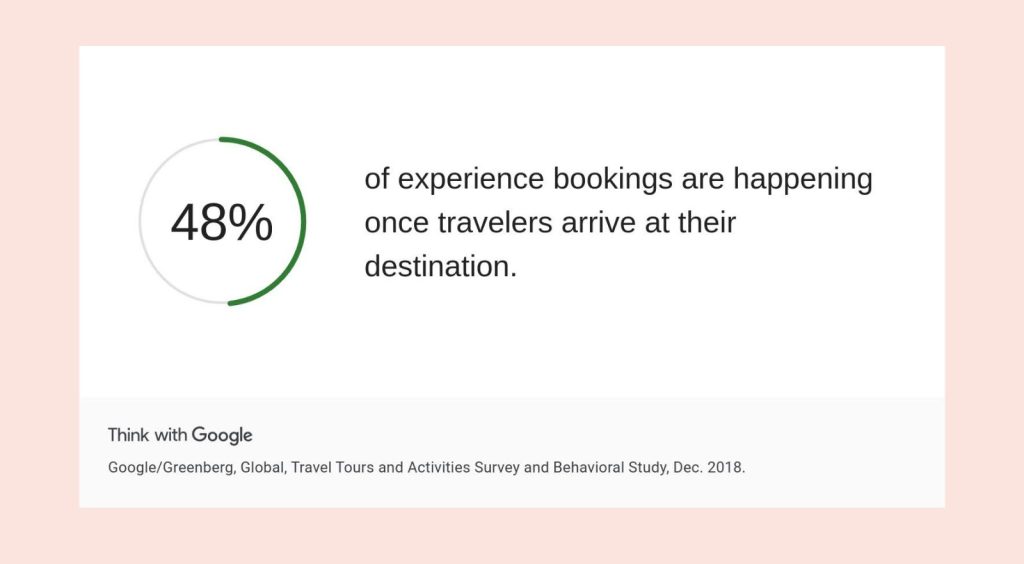
Local SEO involves optimizing your Google Business Profile and website to rank higher for ‘local’ searches, which are searches that include a location. (eg ‘kayaking in montana’).
For example, imagine a searcher writer ‘kayaking in montana’. This keyword includes an activity (kayaking) and a location (montana), making it a local keyword that will pull the Map Pack in Google search:
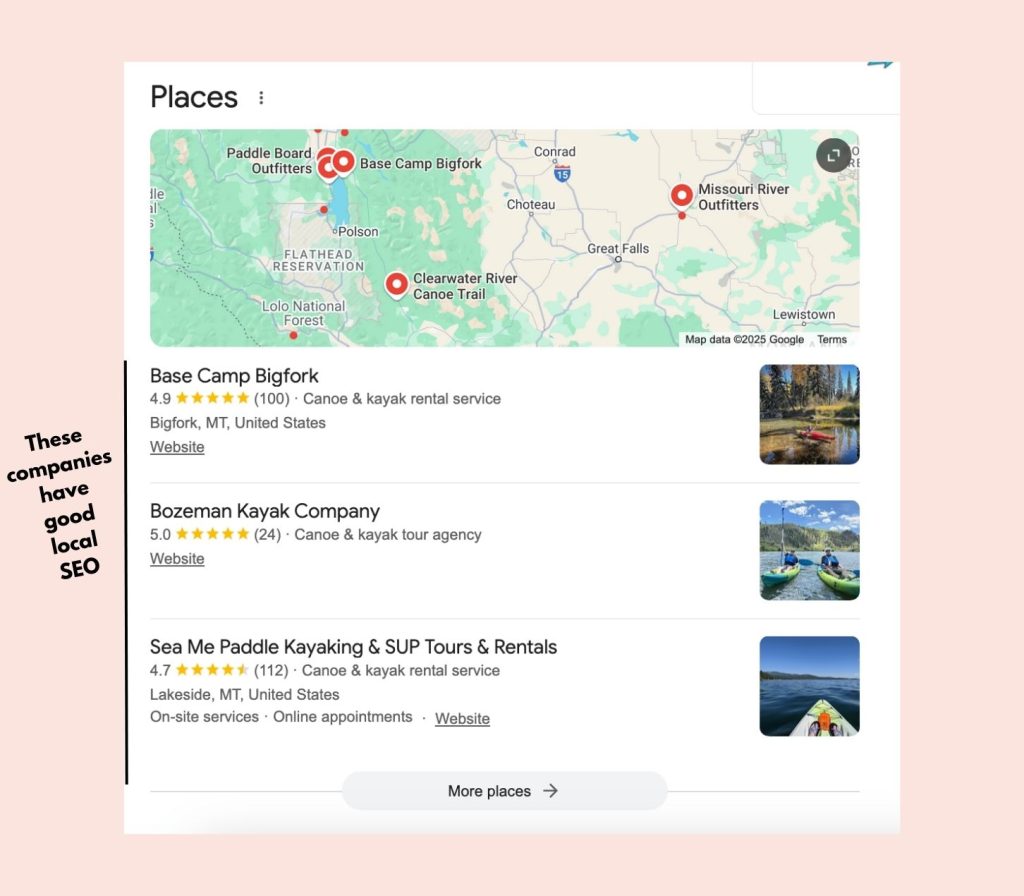
It’s not only the off-the-cuff travelers that local SEO helps to capture, though. The ‘save’ feature on Google Maps, which allows people to leave flags on interesting businesses and locations, is a trusted lifeline for many when planning and researching their trips. Like local searches, however, simply appearing in the map for people to save requires a certain amount of local SEO effort!
There is a lot to local SEO, but beating your competition to rank well for these keywords can be summed up in three steps:
- Optimizing your Google Business Profile for your intended keyword(s) and maintaining it with posts and updates to your business info
- Building citations in online business listings and directories relevant to your offering
- Encouraging positive reviews on your business profile
We have a proprietary method for local travel SEO which allows our clients to capitalize on the sizeable local search volume and bring more spontaneous clients. If this is something you need, get in touch to see if we can help.
Action steps
- Comprehensively fill and keep your business details up-to-date on your Google Business Profile, post photos, updates and reply to reviews
- Create listings in local and national tourism directories
- Offer incentives for guests to leave reviews on platforms like Google
6. Shared interest influencer marketing
With 35% of global consumers looking to social media for travel inspiration, influencer marketing has become critical for the growing travel industry. Many brands, however, take a ‘shotgun’ approach to influencer marketing: they partner up with influencers simply based on their popularity or follow count, which, unfortunately, doesn’t often yield great rewards.
We recommend that travel companies opt to work with more niche social media personalities that align with their brand and values. Even if their following is smaller, this targeted approach ensures that the influencer’s audience is likely to be already interested in your type of travel experience, which will bring more genuine interest vs mass influencer campaigns.
For example, if you run Amazon rainforest tours focused on sustainability, ask a sustainability-focused influencer to come and take photos and videos of your trip–even if they don’t have the biggest social media following. An inherent match like this will create natural and engaging content that builds trust with potential customers, ensuring you get the right kinds of eyes on your tour, hotel or retreat.
Action steps
- Find niche influencers who are aligned with the themes of your tour or hotel (e.g., adventure, sustainability, or location specialists).
- Invite them to experience your service in exchange for content
- Re-use influencer content for your newsletter, ads, website and socials
7. Local business collaboration
One of the most effective ways to grow your tour company from the ground up is by collaborating with other local businesses in your destination. Not only does this tap into an engaged audience–whether visiting or local–but it also builds a network of referrals that can drive consistent bookings in the medium and long-term.
Partnerships with local restaurants, boutique hotels and other experience providers can be more beneficial than you think. For example, if you run tours, a boutique hotel could recommend your service to its guests in exchange for a commission or special perk, or a local café or restaurant could offer discounts to customers who book your tours. Likewise, a local tour company may be able to offer discounts for dining and accommodation in the area. Over time, forging these kinds of strong local relationships can lead to a steady stream of new customers for your travel businesses.
We find these kinds of ‘strategic partnership’ work particularly well for marketing luxury travel. For example, if you offer luxury, off-the-grid retreats, partnering up with other luxury brands who want to please their high-value clientele and giving them first dibs on retreat availability or exclusive offers can be a great way to build more awareness.
Further reading: how to do luxury travel SEO
Digital collaboration is just as powerful; a simple collaborative Instagram post with another local business or cross-promotion in email newsletters can amplify the reach of your businesses even more. Additionally, if you get placed on the website of other local businesses (for example on a list of ‘local recommended locations’) you gain a backlink, which is great for your SEO rankings–and we personally believe SEO is the holy grail of travel marketing.
Consider this a kind of ‘local PR’. It taps into your existing network, and spreads your reach sustainably. If you haven’t explored local partnerships yet, start by thinking about who you already know, identifying businesses that align with your brand, and reaching out to set up collaborations. Who knows what could happen!
Action steps
- Tap into your existing network and connect with boutique hotels, restaurants or other service providers for cross-promotions
- Offer commissions and perks for businesses that send customers your way
- Try and get featured on partner’s websites to help boost your SEO
8. Reach corporate travelers with cold LinkedIn outreach
Another unique angle that we’ve seen working for certain types of tourism brands is to connect with HR and decision-makers in companies that want to give something back to their employees in the form of domestic or international trips.
HR heads, especially for larger companies, are always looking for new places and activities to organize group retreats and corporate team building exercises. In fact, 49% of team event planners said that arranging enjoyable activities is a key priority for them when organizing team meetings. Add that to the fact that ‘bleisure’ (business and leisure) travel is on the rise, we see a unique opportunity to promote your tourism brand to HR stakeholders who are looking for something different.
The natural place to do this is LinkedIn. Carry out a search for HR heads in companies that you know, and simply reach out with a message outlining your brand and asking if they’d like more info. Or, if you have more of a budget, you can even set up a LinkedIn advertising campaign to target HR managers who might be looking for locations like yours.
To sweeten any prospective deal and build a rapport with your prospects, you could offer discounts for group trips or block bookings. By investing some time and energy into this method, you just might make a great connection which can be cultivated over time.
Action steps
- Identify HR professionals in companies that invest in corporate retreats and build an outreach list for LinkedIn
- Run targeted ads on LinkedIn for HR managers searching for corporate retreat locations
- Develop personalized or custom packages with group discounts tailored to individual companies that reply
9. Open up new audiences with website translation
Did you know that 64% of consumers would pay a higher price for a service if a brand offers a customer experience in their native language?
That’s a telling stat. How many languages does your website currently support?
International travel inherently involves people from diverse countries, each speaking different languages, as they explore new destinations. It goes without saying that those people are likely to be searching the web in their native language. Plus, with the rise of voice search, the amount of people who search for travel-related topics in their native language is only set to increase.
It’s not only travelers from different countries who might be searching in other languages; it’s domestic audiences, too. In the US, for example, 67.8 million people are reported to speak languages other than English at home.
That’s why having different versions of your website to cater for your different audiences is paramount. You probably already have a good sense of where your customers come from and which language they speak, but tools like Google Destination Insights can help you gauge the countries where people are most interested in your destination.
For example, using the tool, we can see that Germany is the country with the most inbound destination demand for Italy:
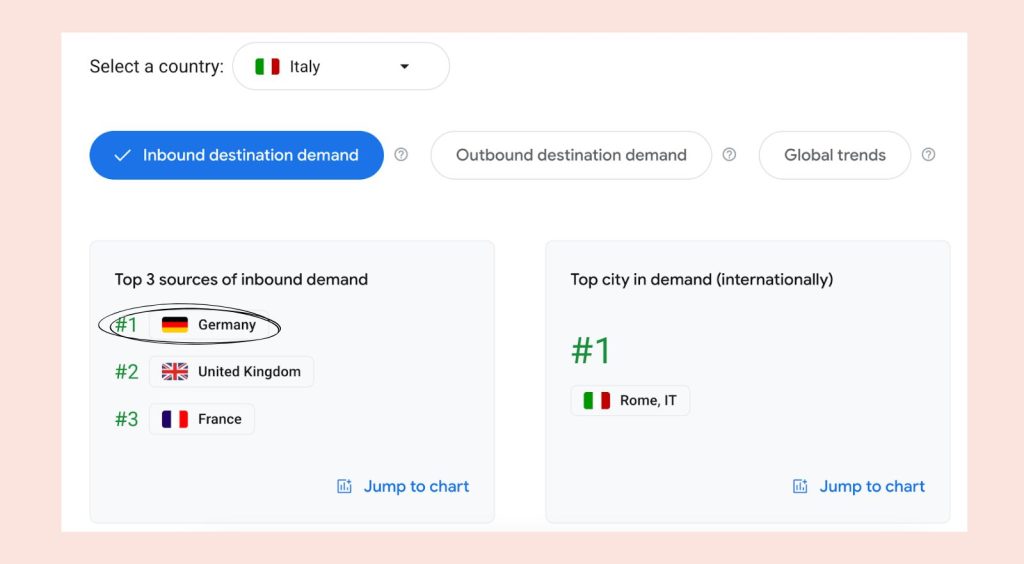
While Italian tourism companies may already have websites in English and Italian, this data tells us that it will be worthwhile to set up an SEO-optimized German version of their website to cater for people searching in German.
There are several ways to do this, from implementing language switchers on your site to creating subdomains for different languages and countries. The best way to create a multilingual website will depend on the size and complexity of your website.
Whichever approach you choose, it’s important that your translated site is optimized for multilingual SEO, which will help you to reach new travelers who are searching in their own language.
Action steps
- Use analytics and tools like Google Trends to see where international interest in your destination comes from
- Create a second language version of your website to cater for popular audiences
- Implement hreflang tags and create country-specific content to optimize for multilingual SEO and attract people searching in other languages
10. Instagram DM automation
Did you know that direct messaging (DM) on Instagram can be a secret weapon for engaging with potential customers? No, we don’t mean sliding into potential travellers’ inboxes. It’s the ‘DM for link’ strategy.
It works by creating a post that teases valuable content like a detailed travel guide or itinerary (this is known as a lead magnet). To get the content, users simply have to leave a comment with a given word or phrase. Imagine you run tours in Cartagena, Colombia, and you create a flashy Instagram post or reel (reels tend to have the highest engagement rate on Instagram) with an enticing call to action, such as:
Want our exclusive 5-day itinerary for Cartagena? DM us ‘CARTAGENA’ and we’ll send you the link!
Then, when users write ‘CARTAGENA’ in the comments, they’ll automatically receive a link in their inbox, which you can set up with a service like Linktree, Manychat or Respond.io. Within that link, the user can leave their email address in exchange for the resource.
This is actually quite a clever strategy, because it:
- Increases the engagement on your post, meaning it’s more likely to be shared to more users
- Builds up a list of people who are interested in your destination (read: warm leads) and gets them onto your email list
- Opens up a conversation: once users have messaged you, you can continue the conversation, answer their questions, and subtly guide them toward booking your tour/hotel/retreat, etc
As for the travel guide or resource itself, it should genuinely provide value, but also naturally incorporate your services. For example, a ‘Best Hidden Gems in Verona’ guide could highlight must-visit locations while subtly suggesting your hotel as the best way to wind down after experiencing them.
This strategy not only increases engagement but also builds a warm audience of travelers already interested in your destination, making them more likely to convert into paying customers.
The best thing about this strategy is that it’s scalable: if automated DMing works well for you, you can put money in to boost your post or reel, which will reach even more travelers and get more sign-ups for your mailing list.
Action steps
- Create an lead magnet like a travel guide or free itinerary
- Use a chatbot tool to auto-send links to users who comment with a keyword
- Encourage users who interact to sign up to your email list and nurture them towards a booking
11. Set up and nurture a mailing list
Think about the last time you checked your email. It was probably a few minutes ago, right?
Most people check their email every single day, multiple times a day, and email still drives 66% of online consumer purchases. Indeed, several of the tourism promotion ideas in this list relate in some way to having a mailing list. We’re big fans of the mailing list.
Unlike social media, where algorithms dictate visibility, email marketing gives you direct access to your audience. By pursuing avenues like SEO content marketing and social media automation, you’ll be able to build a well-curated email list filled with engaged travelers, which will easily become one of your most valuable marketing assets. A list like this drives not only consistent bookings, but die-hard brand loyalty.
You can also segment your emailing list based on when and where different users signed up, or even what they’re interested in (if you collected that data). This allows you to place different segments of users in separate funnels, with unique email sequences. Or, you can retarget people who have signed up to your list, so they see your advertisements in other places around the web.
The key to building an effective mailing list is to offer something of real value. Instead of just asking people to subscribe, entice them with exclusive content from travel writers and photographers that you know. Offer behind-the-scenes travel stories and local insights, or early access to new tour offerings. Whatever it is that makes your type of traveller tick, put in the lead magnet.
Make sure your email list sign-up is front and centre on your website. Encourage sign-ups via social media. Collaborate with influencers who can sign up their audience to your list.
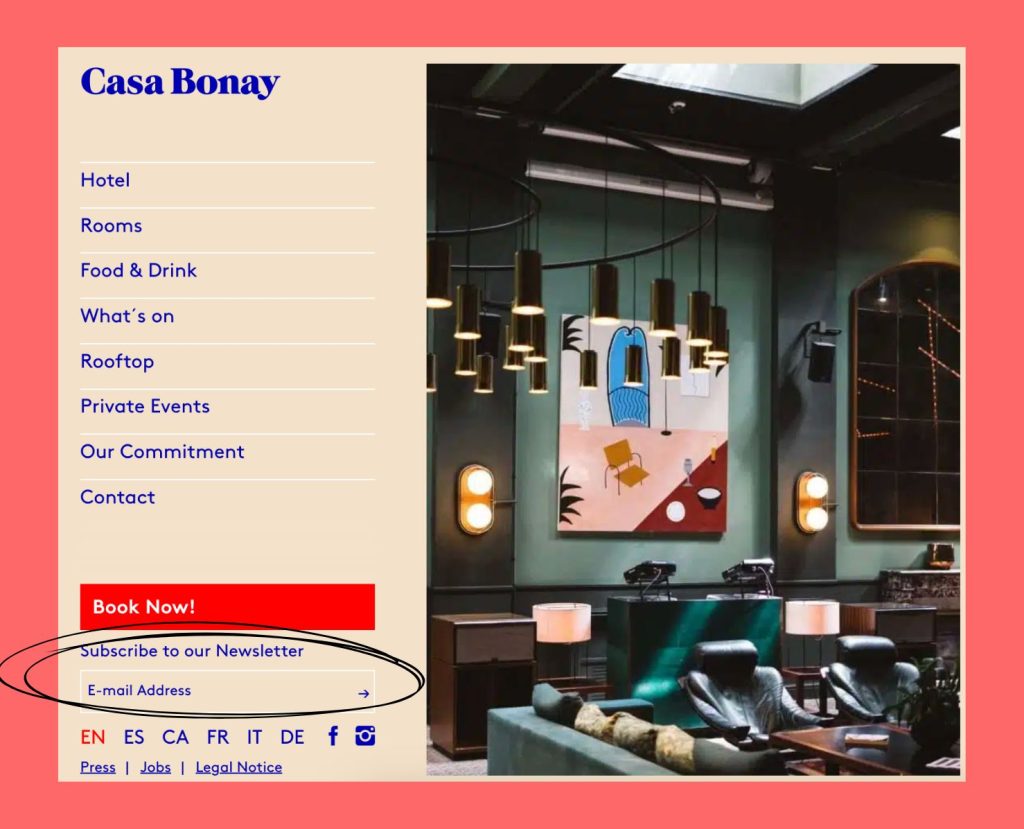
Once you have an engaged audience, you can use your new most powerful asset to nurture leads and drive bookings. Give your subscribers regular newsletters with exclusive travel tips, limited-time discounts, seasonal offers and insider content. Since they’ve already shown they’re interested in travel, and specifically your offering, this kind of content will keep your subscribers interested and encourage them to take action.
Action steps
- Add email newsletter sign-up boxes to your website pages, and offer enticing content in exchange for sign-ups
- Provide subscribers with insider tips, seasonal discounts and well-curated travel content
- Personalize emails based on user behavior (e.g. adventure travelers vs. luxury travelers)
12. Consider a website redesign
As someone who looks at websites of travel and tourism service providers daily, it’s safe to say that much of the industry lags behind when it comes to web design standards.
There are a few reasons for this. For one, many tour and accommodation providers focus solely on their OTA listings, since that’s where the majority of their bookings come from, and they sideline their websites to slowly gain dust in a forgotten corner of the web.
It might also be the case that they originally outsourced their website design to a friend or disreputable agency, who have all but forgotten about it and left it to decay.
Your website is your best chance to make an impressionable impact on potential bookers. Unlike OTA listings and social media profiles, your website is the only place where you are in control of every aspect of the customer journey.
Slow pages, clunky architecture and outdated CMS themes are just some of the issues that make it harder for you to connect with your audience. Your website should make it easy for your clients to make a booking, not harder.
Moreover, with the share of online travel bookings made on mobile forecasted to exceed 50% in 2026, it’s critical that your site functions well across mobile and tablet devices, too.
Take a look at your website and measure it up against similar service providers in your area. What features do they have that you don’t? Is it easy to make a booking on their site? How quickly do their pages load?
If you want to connect with more travelers, I’d strongly advise taking a look at your website, evaluating whether it needs a rehaul, and taking action by contacting a travel web design agency to make sure your website puts your best foot forward.
Action steps
- Audit your current site to check speed, booking flow, user experience and mobile device compatibility
- Update your images, copy, and on-page, or redesign your site from scratch if necessary
- Minimize the amount of steps it takes to make a successful booking and add direct booking incentives
Promotion ideas for an evolving tourism industry
The travel industry is evolving rapidly, and so should your marketing approach. While traditional advertising and OTA listings do remain important, you’ll need a hot mix of creative and data-driven promotion techniques to truly stand out.
Remember, travel marketing mainly comes down to building relationships with travelers so that when they’re ready to book, your brand is top of mind. So, whether you’re refining your website, tapping into corporate travel opportunities or curating content for your email list, each step you take brings you closer to a consistent stream of high-value bookings.
If you’re ready to transform your tourism business with a marketing strategy that drives results, get in touch with me at Parador and find out how to get more clients for your travel business.

